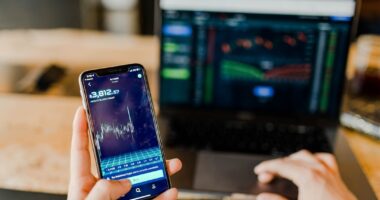NFTs (non-fungible tokens) are unique digital assets stored on a blockchain, which is a decentralized and distributed digital ledger. Unlike fungible cryptocurrencies such as Bitcoin or Ethereum, which can be exchanged on a one-to-one basis, NFTs are non-fungible, meaning each token is unique and cannot be directly exchanged for another. In the art world, NFTs have gained popularity by allowing artists to create and sell digital artwork as unique, verifiable assets.
This development has created new opportunities for artists to monetize their work in the digital space. NFTs are typically bought and sold using cryptocurrency, which is a digital or virtual form of currency that utilizes cryptography for security purposes. Cryptocurrencies operate on blockchain technology, ensuring secure and transparent transactions without the need for a central authority.
The relationship between NFTs and cryptocurrency is crucial for artists interested in participating in the digital art market and NFT sales. Understanding these concepts is essential for navigating the emerging landscape of digital asset ownership and trade.
Key Takeaways
- NFTs are unique digital assets that represent ownership of a specific item or piece of content using blockchain technology.
- Creating digital artwork for NFTs involves using software and tools to produce high-quality, original pieces that can be tokenized and sold.
- Choosing the right NFT marketplace is crucial for reaching the right audience and maximizing the potential for sales and exposure.
- Minting your NFT involves the process of creating a digital certificate of ownership and uploading your artwork to the chosen marketplace.
- Setting a price for your NFT requires careful consideration of factors such as the current market trends, the uniqueness of your artwork, and the demand for similar pieces.
- Promoting your NFT through social media, online communities, and collaborations with other artists can help increase visibility and attract potential buyers.
- Managing your NFT sales and transactions involves keeping track of sales, transfers, and potential royalties, as well as staying informed about any changes in the market or platform policies.
Creating Your Digital Artwork
Key Considerations for Digital Artwork
When creating digital artwork for NFTs, it’s essential to focus on producing high-quality, visually striking pieces that will stand out in the digital marketplace. This may involve experimenting with different software and techniques to achieve the desired aesthetic.
The Importance of Concept and Narrative
In addition to the visual aspect, artists should also consider the concept and narrative behind their digital artwork. NFT collectors are often drawn to pieces that have a compelling story or message, so it’s crucial to think about the meaning and intention behind the work.
Preparing Digital Artwork for Minting
Once the artwork is complete, artists will need to prepare it for minting as an NFT, which involves converting the digital file into a unique token on the blockchain. This process typically involves choosing a blockchain platform, such as Ethereum, and following specific guidelines for creating and uploading the NFT.
Choosing the Right NFT Marketplace

Once your digital artwork is ready to be minted as an NFT, the next step is to choose the right marketplace to list and sell your NFT. There are several NFT marketplaces available, each with its own set of features and benefits. It’s important to research and compare different marketplaces to find the best fit for your artwork and goals.
Some popular NFT marketplaces include OpenSea, Rarible, and Foundation, each offering unique opportunities for artists to showcase and sell their work. When choosing an NFT marketplace, consider factors such as fees, user interface, community engagement, and curation process. Some marketplaces may have higher fees but offer greater visibility and marketing support, while others may be more artist-friendly with lower fees and more control over pricing and sales.
It’s also important to consider the target audience of each marketplace and how well it aligns with your artistic style and vision. By carefully evaluating your options and understanding the strengths of each marketplace, you can make an informed decision that will maximize the potential for your NFT sales.
Minting Your NFT
Minting your NFT is the process of creating a unique token on the blockchain that represents your digital artwork. This process typically involves using a platform that supports NFT creation, such as Ethereum-based marketplaces like OpenSea or Rarible. To mint your NFT, you will need to upload your digital artwork file and follow the specific guidelines provided by the platform.
This may include adding metadata such as title, description, and tags to help potential buyers discover and understand your artwork. When minting your NFT, it’s important to consider factors such as gas fees, which are transaction fees paid to process and validate the creation of your NFT on the blockchain. Gas fees can vary depending on network congestion and other factors, so it’s important to be aware of these costs when minting your NFT.
Additionally, you may have the option to set royalties for secondary sales of your NFT, allowing you to earn a percentage of future sales if your artwork appreciates in value. By carefully navigating the minting process and understanding the associated costs and benefits, you can ensure a smooth and successful launch for your NFT.
Setting a Price for Your NFT
Setting the right price for your NFT is crucial for attracting potential buyers and maximizing the value of your digital artwork. When determining the price of your NFT, consider factors such as the quality and uniqueness of your artwork, your reputation as an artist, current market trends, and demand for similar pieces. It’s important to strike a balance between setting a price that reflects the value of your work while also being competitive in the marketplace.
Some artists may choose to start with a lower price to attract initial interest and build a collector base, while others may set a higher price based on the perceived value of their artwork. Additionally, consider whether you want to offer limited editions or multiple copies of your NFT at different price points. This can create a sense of scarcity and exclusivity that may appeal to collectors.
By carefully evaluating these factors and staying informed about market dynamics, you can set a price for your NFT that reflects the true worth of your digital artwork.
Promoting Your NFT

Social Media Promotion
Social media platforms such as Twitter, Instagram, and TikTok are popular channels for sharing updates about new NFT releases, behind-the-scenes insights into the creative process, and engaging with collectors and fellow artists.
Community Engagement
Engaging with online communities and forums dedicated to NFTs and digital art can also help increase visibility for your work. Participating in discussions, sharing insights, and offering value to the community can help build relationships with potential buyers and collectors. Additionally, consider collaborating with other artists or influencers in the NFT space to cross-promote each other’s work and reach new audiences.
Email Marketing and Newsletters
Another effective strategy for promoting your NFT is to leverage email marketing and newsletters to keep your audience informed about new releases, upcoming events, and exclusive offers. Building an email list of interested collectors can provide a direct line of communication and help nurture long-term relationships with buyers.
By implementing a multi-faceted promotional strategy that leverages various channels and tactics, you can increase awareness and interest in your NFTs.
Managing Your NFT Sales and Transactions
Once your NFT is listed for sale, it’s important to actively manage your sales and transactions to ensure a smooth and successful experience for both you and your buyers. This involves monitoring inquiries from potential buyers, responding to questions or offers promptly, and providing clear information about the purchasing process. Transparency and communication are key to building trust with buyers and fostering positive relationships within the NFT community.
As sales start coming in, it’s important to keep track of transactions, including sales data, royalties earned from secondary sales, and any associated fees or expenses. This will help you understand the performance of your NFTs and make informed decisions about pricing, marketing strategies, and future releases. Additionally, consider offering exceptional customer service by providing timely support for buyers who may have questions or concerns about their purchase.
Managing your NFT sales also involves staying informed about market trends, collector preferences, and changes in the industry landscape. By staying engaged with the community and being adaptable to new developments, you can position yourself for continued success in the world of digital art and NFTs. Overall, effective management of your NFT sales and transactions is essential for building a sustainable career as an NFT artist.
FAQs
What is an NFT?
An NFT, or non-fungible token, is a digital asset that represents ownership or proof of authenticity of a unique item or piece of content, such as digital art, videos, music, or other digital files.
What is digital art creation?
Digital art creation refers to the process of creating artwork using digital tools and software, such as drawing tablets, graphic design software, and digital painting programs.
What are the simple steps to creating your own NFT?
The simple steps to creating your own NFT include:
1. Creating or digitizing your artwork
2. Choosing a blockchain platform for minting your NFT
3. Setting up a digital wallet
4. Minting your NFT
5. Listing your NFT for sale or auction
How do I create or digitize my artwork for an NFT?
You can create digital artwork using graphic design software, drawing tablets, or digital painting programs. If you have physical artwork, you can digitize it by scanning or photographing it with high-quality equipment.
What is a blockchain platform for minting NFTs?
A blockchain platform for minting NFTs is a digital marketplace or platform where artists can create and sell their NFTs. Popular platforms include Ethereum-based platforms like OpenSea, Rarible, and Foundation.
What is a digital wallet and why do I need one for creating NFTs?
A digital wallet is a software program that allows you to store, send, and receive digital assets, including cryptocurrencies and NFTs. You need a digital wallet to store the cryptocurrency used for minting NFTs and to receive payments from NFT sales.
What does it mean to mint an NFT?
Minting an NFT refers to the process of creating and tokenizing a digital asset on a blockchain, which establishes its authenticity, ownership, and scarcity. This process typically involves paying a fee and uploading the digital file to the blockchain platform.
How do I list my NFT for sale or auction?
After minting your NFT, you can list it for sale or auction on a blockchain platform. You can set a price for direct sale or set up an auction with a starting bid and a duration for bidding.





